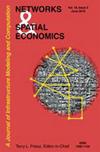Local Factors and COVID-19 Severity: Typological Analysis of Urban Districts in Russia
IF 1.5
3区 工程技术
Q3 OPERATIONS RESEARCH & MANAGEMENT SCIENCE
引用次数: 1
Abstract
The COVID-19 pandemic has demonstrated that the lack of consideration of the local specifics of territories, such as the specifics of socio-economic interactions, labor market characteristics, leads to serious social or economic consequences when developing response measures to epidemiological threats. The creation of a typology of territories (urban districts / okrugs) makes it possible to more accurately select measures to regulate socio-economic interactions in the event of future complications of the epidemiological situation. Clustering of municipalities according to a set of local factors that significantly explain the severity of the pandemic in the first year made it possible to identify three types of urban districts that differ in population size and intensity of socio-economic interactions (SEI): these are key service centers with a high intensity of SEI, local centers with medium SEI intensity, small towns with low SEI intensity当地因素与COVID-19严重程度:俄罗斯城市地区的类型分析
2019冠状病毒病大流行表明,在制定应对流行病学威胁的措施时,如果不考虑各地区的具体情况,例如社会经济相互作用的具体情况、劳动力市场特征,就会导致严重的社会或经济后果。建立领土类型(城市地区/地区)可以更准确地选择措施,以便在未来流行病情况复杂化的情况下调节社会经济相互作用。根据能够显著解释第一年流行病严重程度的一套当地因素对城市进行聚类,从而可以确定人口规模和社会经济相互作用强度不同的三种类型的城市地区:社会经济相互作用强度高的关键服务中心、中等社会经济相互作用强度的地方中心、低社会经济相互作用强度的小城镇
本文章由计算机程序翻译,如有差异,请以英文原文为准。
求助全文
约1分钟内获得全文
求助全文
来源期刊

Networks & Spatial Economics
社会科学-运筹学与管理科学
CiteScore
4.00
自引率
4.20%
发文量
26
审稿时长
>12 weeks
期刊介绍:
Networks and Spatial Economics (NETS) is devoted to the mathematical and numerical study of economic activities facilitated by human infrastructure, broadly defined to include technologies pertinent to information, telecommunications, the Internet, transportation, energy storage and transmission, and water resources. Because the spatial organization of infrastructure most generally takes the form of networks, the journal encourages submissions that employ a network perspective. However, non-network continuum models are also recognized as an important tradition that has provided great insight into spatial economic phenomena; consequently, the journal welcomes with equal enthusiasm submissions based on continuum models.
The journal welcomes the full spectrum of high quality work in networks and spatial economics including theoretical studies, case studies and algorithmic investigations, as well as manuscripts that combine these aspects. Although not devoted exclusively to theoretical studies, the journal is "theory-friendly". That is, well thought out theoretical analyses of important network and spatial economic problems will be considered without bias even if they do not include case studies or numerical examples.
 求助内容:
求助内容: 应助结果提醒方式:
应助结果提醒方式:


